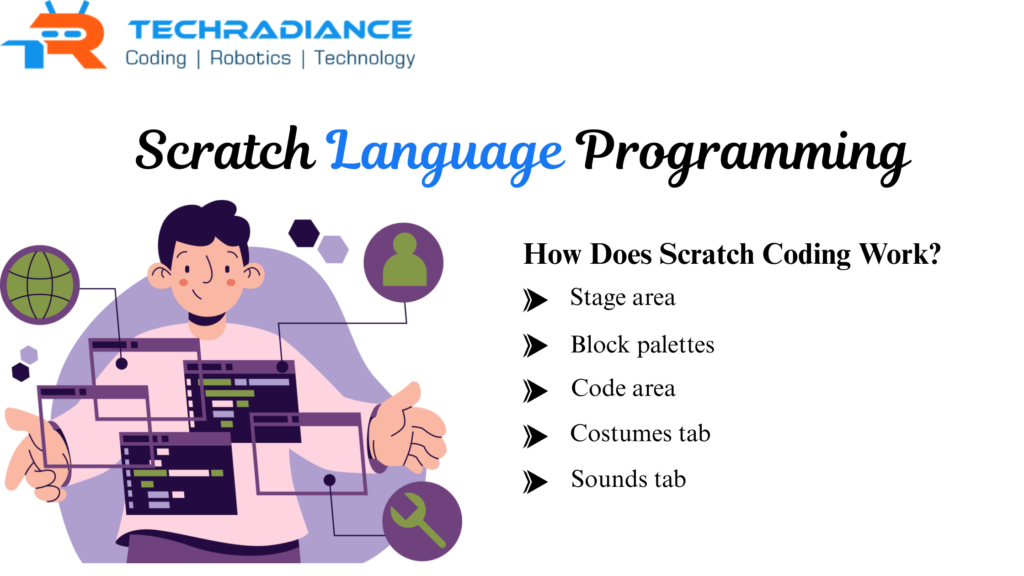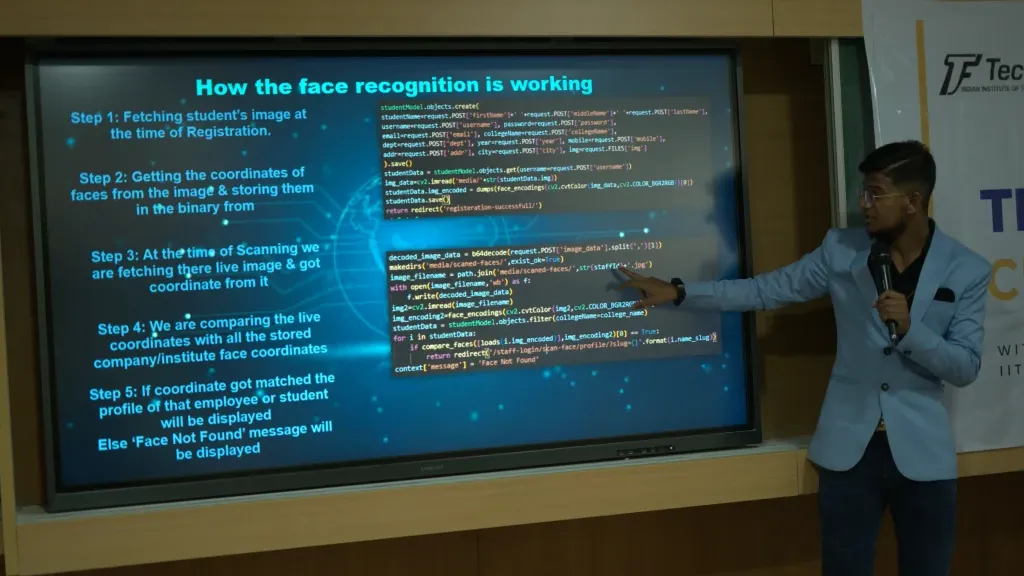Scratch Language Programming: We are living in a time when coding is considered an essential skill, much like reading or arithmetic. Children growing up in this environment need to develop digital fluency early, and coding classes designed specifically for them have emerged as a critical tool in fostering this skill. Among the most popular and effective programming languages for kids are Scratch and Python. Both of these platforms introduce young minds to the world of coding, but they do so in ways that are age-appropriate, engaging, and empowering.
Let’s explore how learning to code using Scratch and Python benefits kids, highlighting key differences between the two while emphasizing the long-term advantages of coding as a foundational skill for the future.
What is Scratch?
Scratch is an interactive programming platform developed by MIT, designed to introduce children aged 7 and up to the world of coding playfully and intuitively. Instead of typing complex lines of code, Scratch allows kids to snap together colorful coding blocks to create animations, games, and stories. This visual interface helps children grasp the fundamental concepts of coding, such as loops, conditionals, and variables, without the overwhelming complexity of text-based programming. Scratch language programming is a key feature that enables kids to learn coding in an engaging and accessible way.
Scratch’s greatest strength lies in its ability to stimulate creativity. Children are not just passively following instructions but are encouraged to think like problem solvers. They can design their characters, animate them, and tell interactive stories, all while unknowingly learning key coding concepts. This freedom to experiment, build, and play turns what might seem like a technical skill into a fun and expressive activity. Scratch language programming offers this unique blend of creativity and coding, making it an engaging platform for young learners.
Moreover, Scratch fosters community learning. With a vast online platform where kids can share their projects, give and receive feedback, and remix others’ creations, Scratch becomes more than a tool; it becomes a global collaborative space. This interaction promotes teamwork and creativity, making coding a social experience as well as a personal journey.
Why choose Scratch?
Scratch language programming is the perfect gateway for kids to begin their coding journey. Its drag-and-drop interface eliminates the need to memorize syntax, allowing young learners to focus on problem-solving and creativity. With Scratch, children can easily create animations, games, and interactive stories, making it a fun and engaging way to introduce the core principles of programming without overwhelming them with technical details.
What is Scratch Language Programming?

Scratch Language Programming is a block-based programming platform for beginners that allows users to create games, animations, and interactive tasks. It makes programming easier by providing an intuitive interface that makes it ideal for both students and newcomers. With drag-and-drop, users can master coding with no prior knowledge. Techradiance provides instructions to help students explore the creative possibilities offered by Scratch. It’s an enjoyable and engaging approach to improving problem-solving skills and thinking abilities.
Benefits of the Scratch Language Programming
Coding language Scratch is a fantastic tool for beginning users, particularly youngsters, to master the basics of programming in an enjoyable, interactive manner. It was developed by MIT. The Scratch language is an underlying block-based system of coding that allows users to make games, animations, and interactive stories without requiring prior coding experience. The visual approach assists in developing problem-solving abilities as well as logical thinking and imagination. Additionally, it encourages collaboration because users can collaborate on their projects with the world.
We at Techradiance encourage our youngsters to play with Scratch in order to establish a solid base in programming, making it much easier to switch to advanced language programming in the near future.
Why Python?
While Scratch serves as a gentle introduction, Python is the next step in a child’s coding journey. Python is widely regarded as one of the most beginner-friendly programming languages due to its simple and readable syntax. Children as young as 10 can start coding in Python, progressing from building basic programs to developing more complex applications!
Python serves as an excellent language for teaching computational thinking. Unlike Scratch language programming, Python is a text-based language that offers more flexibility and power. Children learning Python can create everything from simple games to solving mathematical problems or building websites. Python’s versatility makes it an ideal choice for kids who are ready to move beyond the visual coding blocks and tackle real-world programming challenges
Additionally, Python’s popularity in the tech world means that children who start learning it at a young age are building a skill that will remain relevant as they grow older. From AI to web development, Python is a language used across a wide variety of industries, making it a valuable asset in any child’s digital toolbox.
Learning Benefits Beyond Coding
While the obvious benefit of Scratch and Python is coding proficiency, the advantages go far beyond just learning to program. Both platforms, including Scratch language programming, encourage problem-solving skills, logical reasoning, and perseverance. Coding requires children to break down complex problems into manageable steps, fostering a mindset that can be applied in numerous areas of life.
In Scratch, for example, when kids attempt to create a game and encounter a bug, they learn how to troubleshoot and refine their work. Python, on the other hand, introduces them to the idea of debugging and writing efficient code, encouraging them to think critically about their solutions. This iterative process teaches resilience and determination—skills crucial in both academic and real-life scenarios.
Coding also encourages creativity. In Scratch, kids design their interactive worlds, while in Python, they can build functional programs that solve everyday problems. Enrolling in a course on Python programming allows children to combine creativity and logic, helping them develop a balanced skill set that merges technical ability with imaginative thinking.
Moreover, these coding experiences often inspire curiosity about how technology works. Kids who engage in Scratch language programming gain a better understanding of the digital tools they interact with daily, sparking their interest in future careers in tech fields such as software development, robotics, and data science.
The Future is Digital
As we move deeper into the digital age, coding is no longer a niche skill reserved for tech enthusiasts. It’s becoming a foundational skill for everyone, much like reading or writing. By teaching kids to code early on, we are equipping them with the tools to navigate and succeed in a tech-driven world.
Scratch and Python both play pivotal roles in this journey. Scratch gives younger children the perfect foundation, with its colorful and intuitive interface sparking curiosity and creativity. Python, with its text-based approach, allows older kids to take that next step toward mastering programming logic and preparing them for real-world applications.
Conclusion
Coding classes using Scratch Language Programming and Python are more than just opportunities for children to learn a technical skill. They are invitations to explore creativity, problem-solving, and the joy of building something from scratch.
We offer Coding Courses in Scratch and Python to prepare kids for future careers and also instill in them a lifelong love of learning and discovery!
Frequently Asked Questions:
Q1. What is Scratch language programming?
Scratch is a visual programming language that assists beginners in learning programming through animated games and animations.
Q2. Why should my child learn the coding language Scratch?
It helps develop creativity, logic, and problem-solving abilities in a fun and engaging manner.
Q3. Is Scratch suitable for all age groups?
Scratch is a great game for children aged 7-16, however, anyone can begin learning about it.
Q4. What will students create during the Scratch programming class
They’ll create stories, games, and animations as they learn the fundamentals of programming.
Q5. Why choose Techradiance for Scratch classes?
We provide expert trainers and live sessions as a project-based learning method.

